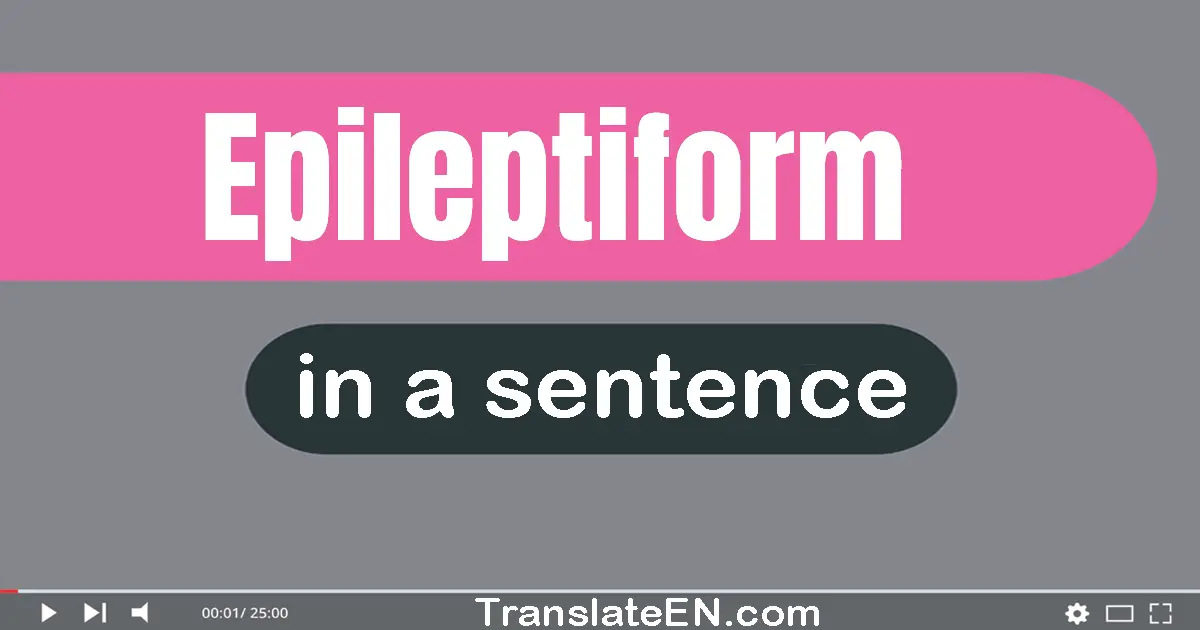Epileptiform in a sentence

(1) The EEG showed epileptiform activity in the brain.
(2) The doctor diagnosed the patient with epileptiform discharges.
(3) The child's behavior was consistent with epileptiform behavior.
(4) The epileptiform spikes on the EEG indicated a seizure disorder.
(5) The EEG showed no evidence of epileptiform activity in the brain.
(6) The neurologist diagnosed the patient with epileptiform epilepsy.
(7) The EEG technician noted epileptiform spikes during the recording.
(8) The child's seizures were characterized by epileptiform discharges.
(9) The patient's EEG showed epileptiform activity in the temporal lobe.
(10) The patient's epileptiform activity was triggered by flashing lights.
Epileptiform sentence
(11) The EEG showed a gradual decrease in epileptiform activity over time.
(12) The EEG showed epileptiform activity in both hemispheres of the brain.
(13) The patient's epileptiform discharges were more frequent during sleep.
(14) The patient experienced an epileptiform seizure during the examination.
(15) The patient's medical history included a previous epileptiform episode.
(16) The EEG technician recorded several instances of epileptiform discharges.
(17) The patient's epileptiform seizures were well-controlled with medication.
(18) The patient's epileptiform episodes were triggered by stress and anxiety.
(19) The patient's MRI revealed a lesion in the area of epileptiform activity.
(20) The patient's medication was adjusted to control the epileptiform activity.
Epileptiform make sentence
(21) The doctor explained the potential risks associated with epileptiform seizures.
(22) The neurologist observed epileptiform activity during the patient's sleep study.
(23) The administration of picrotoxin can induce epileptiform activity in brain slices.
(24) The patient's family was educated on how to respond during an epileptiform episode.
(25) The patient's EEG revealed intermittent epileptiform activity in the temporal lobe.
(26) The EEG technician identified a pattern of epileptiform spikes during the recording.
(27) The neurologist prescribed medication to control the patient's epileptiform seizures.
(28) The patient experienced an increase in epileptiform episodes after stopping medication.
(29) The neurologist explained the different types of epileptiform discharges seen on the EEG.
(30) The patient's epileptiform activity was most prominent during periods of sleep deprivation.
Sentence of epileptiform
(31) The neurologist discussed the potential long-term effects of recurrent epileptiform seizures.
(32) The neurologist recommended further testing to evaluate the extent of the epileptiform activity.
(33) The doctor prescribed antiepileptic medication to reduce the frequency of epileptiform episodes.
(34) The doctor recommended lifestyle modifications to help manage the patient's epileptiform episodes.
(35) The EEG technician monitored the patient's brain activity for any signs of epileptiform discharges.
(36) The EEG technician identified a specific region of the brain where the epileptiform discharges originated.
(37) The neurologist recommended further testing to determine the cause of the patient's epileptiform activity.
(38) The doctor explained the importance of regular follow-up appointments to monitor the patient's epileptiform activity.
(39) The patient's epileptiform seizures were successfully managed with a combination of medication and lifestyle changes.
Epileptiform meaning
Epileptiform is an adjective that describes something that resembles or is characteristic of epilepsy. It is a term that is commonly used in medical contexts to describe certain types of seizures or electrical activity in the brain that is similar to that seen in epilepsy. If you are looking to use the word epileptiform in a sentence, there are a few tips that can help you to do so effectively. Here are some suggestions:
1. Understand the meaning of the word: Before you attempt to use the word epileptiform in a sentence, it is important to have a clear understanding of what it means. This will help you to use it correctly and in the appropriate context. As mentioned earlier, epileptiform refers to something that resembles or is characteristic of epilepsy. This could include seizures, electrical activity in the brain, or other symptoms associated with the condition.
2. Use it in a medical context: Epileptiform is a term that is most commonly used in medical contexts. If you are writing about epilepsy or a related condition, using the word epileptiform can help to convey your meaning more precisely.
For example, you might write, "The patient exhibited epileptiform activity on the EEG."
3. Provide context: When using the word epileptiform in a sentence, it is important to provide enough context so that the reader understands what you are referring to. This might involve explaining what epilepsy is, or providing additional information about the specific symptoms or characteristics that you are describing.
4. Be precise: When using technical terms like epileptiform, it is important to be precise in your language. Avoid using vague or general terms that might be open to interpretation. Instead, use specific language that accurately conveys your meaning.
5. Use it sparingly: While the word epileptiform can be useful in certain contexts, it is important to use it sparingly. Overusing technical terms can make your writing difficult to read and understand, and may even come across as pretentious or showy. Use the word only when it is necessary to convey your meaning accurately.
In conclusion, the word epileptiform is a technical term that is commonly used in medical contexts to describe certain symptoms or characteristics associated with epilepsy. To use it effectively in a sentence, it is important to understand its meaning, provide context, be precise in your language, and use it sparingly. By following these tips, you can use the word epileptiform in a way that is clear, accurate, and effective.
The word usage examples above have been gathered from various sources to reflect current and historical usage of the word Epileptiform. They do not represent the opinions of TranslateEN.com.
